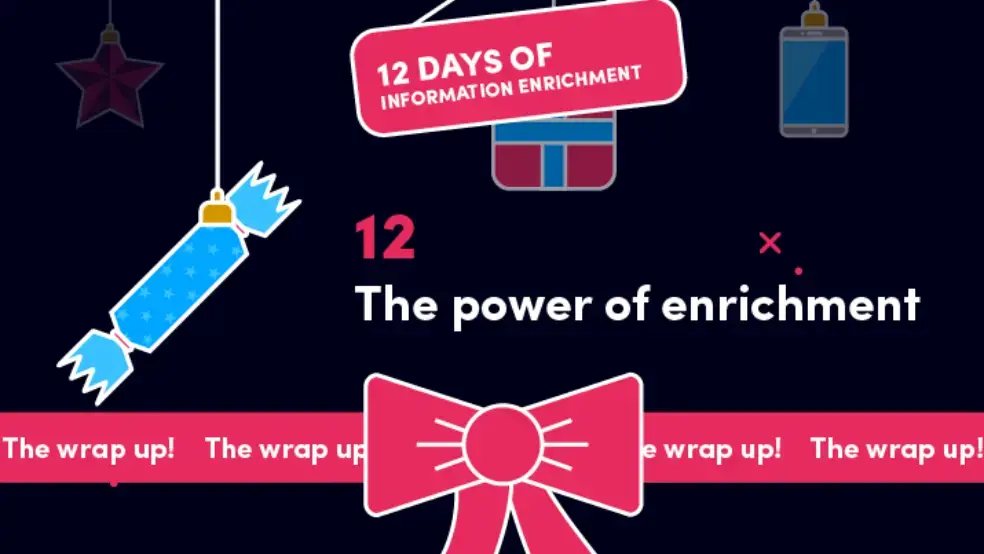Enrichment: The power of Enrichment

Finally, it's almost Christmas - and the last blog in my Information Enrichment series is here! I thought I would use it to wrap things up (!) and explain a little about how everything I've discussed so far fits together to show that enrichment is very powerful process.
At Aiimi, we have spent a significant amount of time researching and building innovative ways to enrich information and add much needed context to it. This means that, as a business, you can really put your information to work.
In this blog series, we've seen fairly simple processes, like how we can take documents and convert them to text, as well as some really quite cool stuff, like named entity recognition, classification, image recognition, dynamic topics and more. We have also seen how this process of enrichment can be used to make meaningful, contextualised recommendations to business users.
All of this Enrichment, in one place
But, how does the information that we enrich get into our platform in the first place, and where does it end up?
Well, the platform InsightMaker provides a whole host of source system connectors. These connectors concern themselves with extracting information from source systems, both structured and unstructured, and then passing this to the enrichment pipelines. We have source connectors for all sorts of systems including file shares, OpenText Content Sever, SharePoint, Office 365, Dropbox, Gmail, Microsoft Exchange - the list goes on. And they are smart too, allowing us to efficiently process deltas so that we can keep the indexes up to date.
Then we have a super-scalable repository which is based on Elasticsearch. This allows us to store hundreds of millions of enriched pieces of information and then provide blisteringly fast response times to users who are searching for them.
Next, we have a 'gateway' layer that provides proper document-level permissions trimming, auditing and a rich API that allows our customers to build their apps and leverage their enriched data store for data science activities. All that enriched data can be made available to data scientists to do their magic and answer questions you previously had no way of answering.
Lastly, there's a layer of prebuilt apps such as Enterprise Search, PII Finder (for GDPR compliance), User Monitoring and Storage Overview, all of which give users access to the repository in different ways. Alongside this, there's data science exploration tools and features, which open a whole host of opportunities to make the most of information.
At the heart of all this, is enrichment. That’s the magic that really adds value to your information. It’s enrichment that begins to structure the unstructured, allows us to drive recommendations, automate business processes, support key business activities, and make big business decisions with our information.
Enrichment also underpins our ability to begin to understand our knowledge networks in the business; connecting people and concepts together and maximising the investment that individuals make in authoring content, authoring knowledge, in the organisation. And it’s that knowledge that sets one business apart from another. Being able to tap into it and, in doing so, accelerate decision making. Being the first to market and to outsmart the competition.
Add a data science layer to your enriched information stores and you are now able to do data science on unstructured data, something that to date has always presented a challenge. The wealth of information locked away in the unstructured world is staggering and presents great opportunity.
So, after 12 posts all about Information Enrichment, that’s it from me in this series! I hope you have found it interesting and hopefully you have some ideas on how the concepts and capabilities within Enrichment can be applied in your business. Even if you start small, I think you will be surprised what is possible when you really start putting your information to work.
Have a lovely Christmas and wishing you a Happy New Year. Cheers, Paul
If you missed my blogs in the 12 Days of Information Enrichment series, you can catch up here.
Day 1 - What is enrichment? Creating wealth from information
Day 3 - Structuring the unstructured with Business Entity Extraction
Day 7 - Advanced Entity Extraction with Natural Language Processing
Day 8 - Understanding customers with Speech to Text translation
Day 9 - Accelerating classification with Document Clustering
Day 12 - The power of Enrichment
Stay in the know with updates, articles, and events from Aiimi.
Discover more from Aiimi - we’ll keep you updated with our latest thought leadership, product news, and research reports, direct to your inbox.
You may unsubscribe from these communications at any time. For information about our commitment to protecting your information, please review our Privacy Policy.



